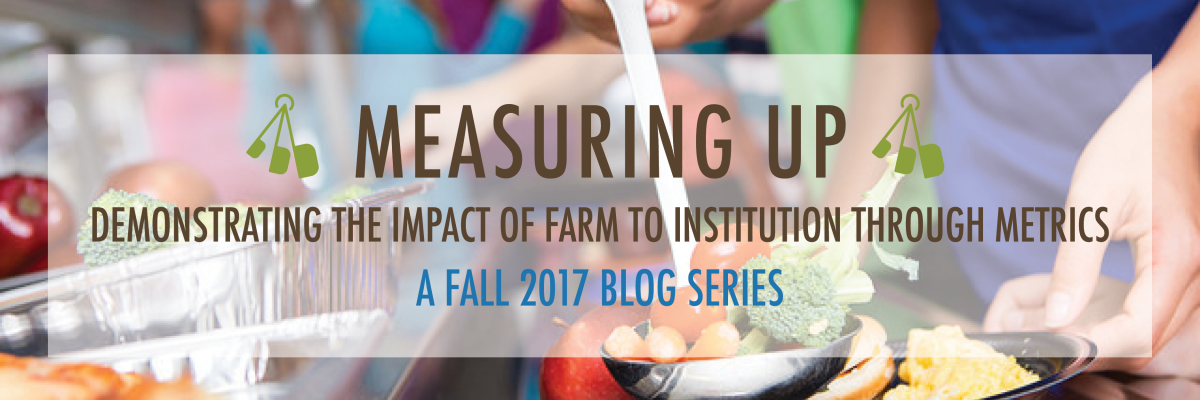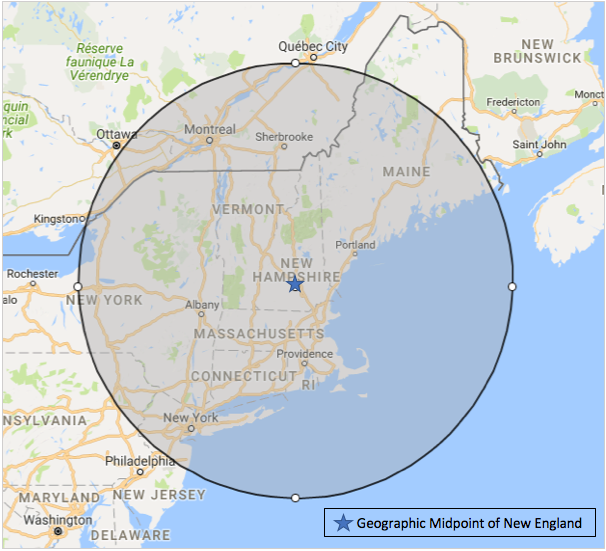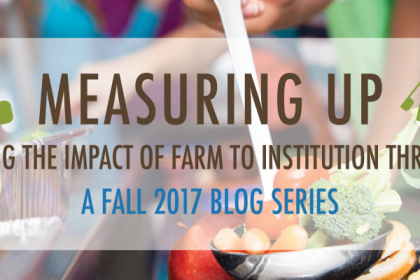
This installment was originally posted on the Farm to Institution New England (FINE) blog.
INSTALLMENT NO. 2 OF 6
Local food programs at New England schools, institutions of higher education, and hospitals are increasing in breadth and depth, however, there is no agreed upon definition of the term “local.” FINE does not assign a set definition of local when collecting primary data but rather allows survey respondents to define “local” for themselves. Data collected and produced by FINE’s metrics team shows that institutions and key players across the value chain define local in a number of ways ranging from “within 50-mile radius” to “within New England.” These definitions are important when it comes to measuring, tracking, and communicating about farm to institution efforts and the local food system in general.
Defining Local
Figures 1 and 2 demonstrate how K-12 schools and colleges are defining local based on data from the USDA Farm to School Census and FINE’s Farm to College Dining Survey.
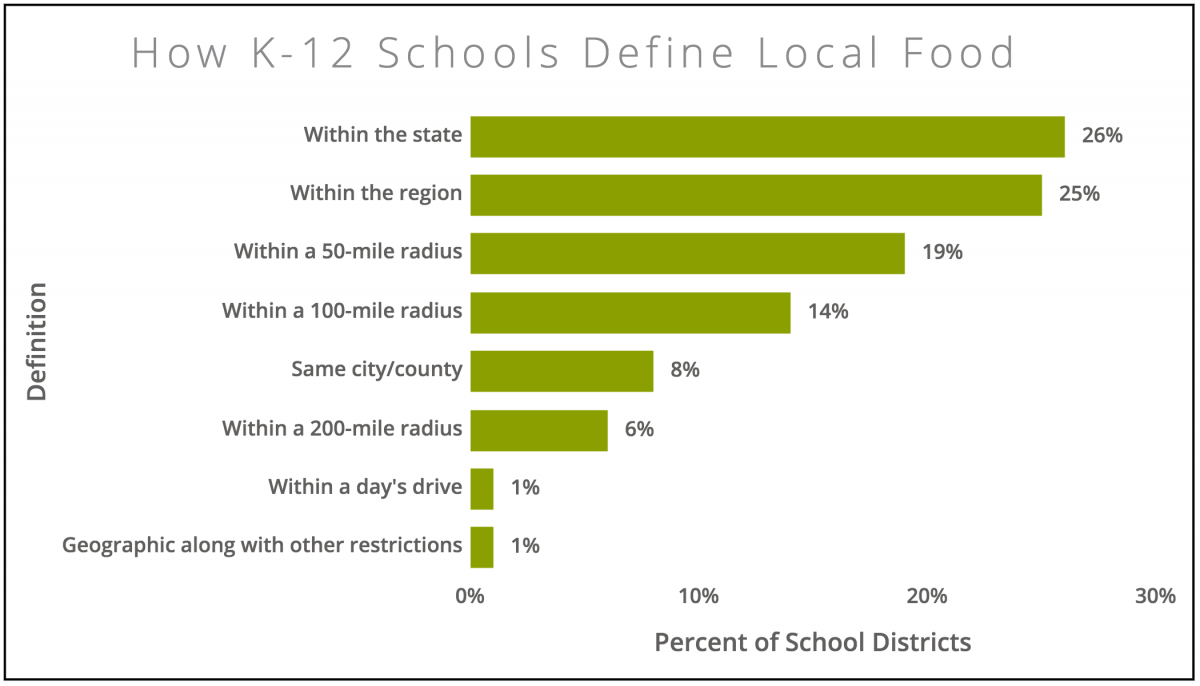
Figure 1: How K-12 respondents in New England define local according to the USDA Farm to School Census (N=464)

Figure 2: How college and university respondents in New England define local according to FINE’s Farm to College Dining Survey (N=100. Respondents could choose more than one option.)
Survey results show considerable variation in how respondents at these institutions define local. The top three answers for K-12 school respondents were “within the state,” “within the region,” and “within a 50 mile radius [1],” while the top three answers from college and university respondents were “within a 250 mile radius,” “within the state,” and “within New England.
While some institutions create their own definitions of local, others use third-party tools or federal/state definitions. The 2008 Food, Conservation, and Energy Act (2008 Farm Bill) defined local as less than 400 miles from a product’s origin or within the state in which it was produced. By this definition, parts of Virginia would be considered local to southern Connecticut – this definition is not generally considered to be appropriate for New Englanders focused on promoting local food. In Vermont, legislation has been passed that defines local as goods that “originated within Vermont or within 30 miles of the place where they are sold, measured directly, point to point.”
In New England, it is common to use tools like the Association for the Advancement of Sustainability in Higher Education’s (AASHE) Sustainability Tracking, Assessment & Rating System (STARS) or the Real Food Challenge (RFC) Calculator. RFC and AASHE have partnered to design an aligned definition of “local and community-based.” Local is defined as foods grown, caught, and/or processed within a 250-mile radius (extended to 500 miles for meat; for products with multiple ingredients, like baked goods, 50% of ingredients must be sourced from within 250 miles) [2]. In their Real Foods Standards Package, RFC says the decision to use 250 miles was made in part because “250 miles has been determined to be roughly the maximum distance that someone can drive, conduct business (such as selling at a farmers’ market or institution) and return on the same day.”
Health Care Without Harm’s Healthy Food in Health Care (HFHC) Survey is FINE’s primary source of farm to hospital data; this survey does not ask respondents for a definition but rather also defines local as “farms, ranches, and production/processing facilities located within a 250-mile radius of the facility.” For processed foods with multiple ingredients, more than 50% of ingredients must fit into the above definition. For much of New England, 250 miles allows for products coming from all six states. Figure 3 shows the 250-mile radius around Dunbarton, New Hampshire, the geographic midpoint of New England. To explore what a 250-mile, or other radius, looks like from different points, click on the map.
Figure 3: 250-mile radius around the geographic midpoint of New England. Map data © 2017 Google.
Tracking Local
Having clear definitions becomes important as institutions determine how they will track their local purchases. Tracking local procurement allows institutions to set realistic goals, measure progress over time, and allows for comparisons of local procurement between institutions and sectors. In FINE’s Farm to College Dining Survey, 65% of respondents reported that they currently use a tracking tool of some kind. Tracking requires systems, staff time, and specific skills that are not part of the procurement operations of many institutions; as such, 35% of respondents reported that they do not use a tracking tool (See Figure 4).
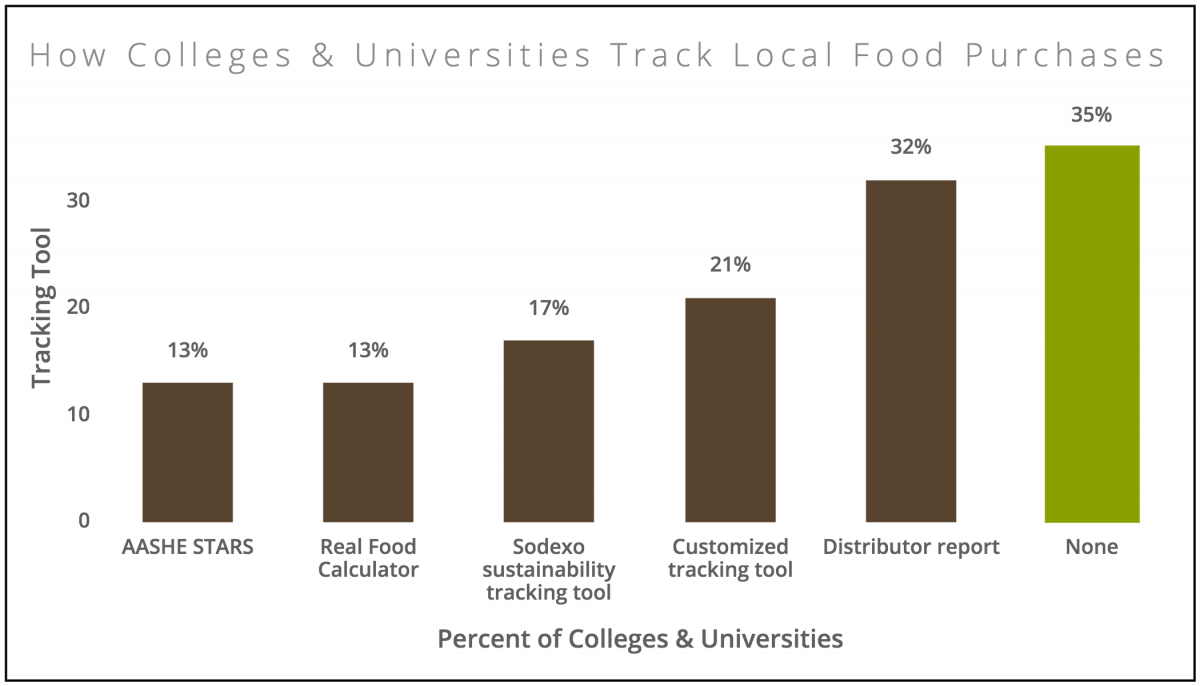
Figure 4: Tracking tools used by college and university respondents in New England (N=100. Respondents could choose more than one answer. Other companies have tracking tools, but the survey did not ask about other proprietary tracking tools.)
Of those that do track local purchases, the most commonly used tool was a distributor report. Food distributors serve as key connectors for producers and institutions. In a 2015 Food Distributor Survey performed by FINE and Health Care Without Harm, responding distributors reported an aggregated $1.12 billion in sales in 2014 [3]. Distributors who provided institutional sales figures reported an aggregated $366 million in institutional sales which accounted for 47% of their gross sales [4].
As demand for local product continues to grow at the institutional level, distributors face increased pressure to work with local producers. According to survey findings, they also play an essential role in providing transparent and accurate sourcing information for their customers; 32% of colleges and universities reported using their distributor reports to track local purchases (See Figure 4). These intermediaries, however, use varying definitions for local as well. Surveyed distributors were asked to provide their definition of local for the purposes of procurement and marketing, and the top three responses were “produced within the state,” “produced within the region,” and “other.” The full list of responses is shown in Figure 5.

Figure 5: How distributor respondents in New England define local (N=26. Respondents could choose more than one option.)
This lack of shared language poses significant challenges for data collection and reporting. Being able to adequately track and measure local procurement becomes complicated when key players are using different units to do the measuring. If a college defines local as “within the state” but is tracking local procurement through a distributor who defines local as “within the region,” the measurement is skewed.
One way distributors are addressing this issue is by providing multiple definitions of local for a single product (for example, “local” as “produced within a state” and “produced within a region”), or simply providing information on the source of origin so that institutions can make their own calculations. FINE is currently conducting research to capture and evaluate current farm to college tracking processes and tools being used in New England – a full report will be available later this fall.
While FINE does not advocate for a single definition of “local” in New England, we do support the development of clear definitions so that these efforts can be measured over time. Examining these different definitions also helps stakeholders understand the broader farm to institution landscape in the region. For example, Real Food Challenge extends its definition of local to 500 miles for meat, reflecting a scarcity of meat processing facilities. The extended distance allows producers to travel to processors and then on to the consumer without giving up their “local” classification.
With this in mind, FINE can make recommendations to its stakeholders regarding a need for increased support for regional infrastructure like processing facilities. These and other recommendations will be explored in more detail in installment No. 6 of this Measuring Up series. Having shared terminology can also help expand the impact of this work outside the region and across the country. As farm to institution metrics work becomes more commonplace in other states and regions across the country, establishing a shared set of definitions and key indicators is an important first step.
FINE wants to know what you think! Should there be a set definition of “local” food? Should it be state-wide? Regional? National? Share your thoughts in the comments section at the bottom of this page and share how you define local where you live.
Footnotes
[1] Note that response language varies because the K-12 survey was performed nationally while the college survey was performed specifically in New England. [2] Note that the distance between producer and consumer is only one part of RFC’s definition of “local and community-based.” In their definition, they also consider the size and ownership structure of farms and producers, as well as traceability. A product is not considered local unless it meets those requirements as well. RFC considers “real” food to be local/community-based, fair, ecologically sound, and humane. [3] These numbers only represents those distributors who provided gross sales figures (25 of the 56 respondents). The actual number is likely much higher. Note that two of the respondents accounted for over half of the aggregated gross sales. [4] Twenty-three of the 25 respondents who provided gross sales reported institutional sales.Coming Up Next
The average annual food and beverage budget for New England colleges ranges from $23,000 to $25 million. In the next installment of Measuring Up, we will look at how these institutional budgets and other operational characteristics affect local procurement.
Measuring Up is a six-part blog series designed to provide an introduction to the importance of data in understanding the farm to institution landscape in New England. The information shared through this blog reflects the respondents who voluntarily participated, and not the entire New England population; survey and census data are self-reported and may conflict with other data sources.
Hannah Leighton is a Research Associate with Farm to Institution New England working with the metrics team.

